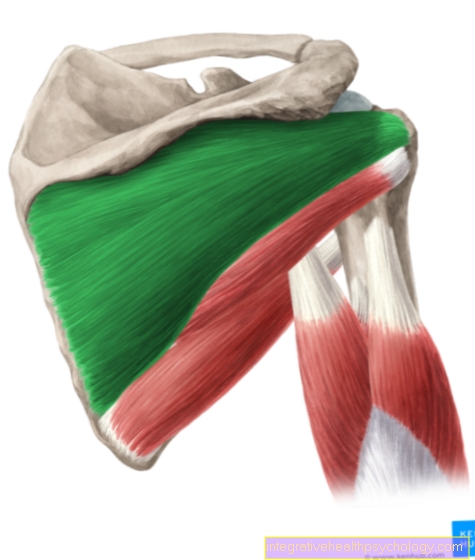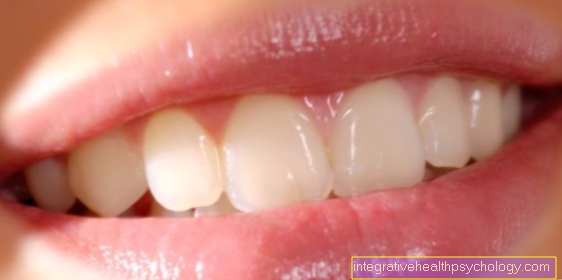Diclofenac
Explanation / definition
Diclofenac (e.g. Voltaren ®) belongs to the group of non-steroidal anti-inflammatory drugs (NSAIDs), so it is a pain reliever. In addition to good pain-relieving, it also has anti-inflammatory and fever-lowering potency. Compared to ibuprofen, the anti-inflammatory effect is more pronounced.

Trade names
- Voltaren
- Diclofenac + manufacturer name
- Diclo
- Diclophlogont
- Diclo-Puren
- Diclo 50
- Diclo 100
Chemical name
- C14H10Cl2NO2Na (sodium salt)
- C14H11Cl2NO2 (free acid)
- [2- (2,6-dichloroanilino) phenyl] acetic acid
application areas
Typical areas of application for diclofenac are:
- arthrosis
- Rheumatoid arthritis
- Swelling conditions after sports injuries and surgery
- Back pain
- disc prolapse
- Transient osteoporosis
Application forms
Diclofenac ointment
Diclofenac can also be used in the form of an ointment. It is used especially for injuries to the muscles, ligaments and joints of the arms and legs. Such injuries can be bruises, strains or sprains caused, for example, by a sports accident.
The ointment contains the same active ingredient as the diclofenac in tablet form. Since the active ingredient does not have to be absorbed and transported to the painful area via the blood when the ointment is used, the dose of the active ingredient is usually lower here. About 3g of the ointment should be applied directly to the painful or swollen area a maximum of three times a day.
Unless otherwise prescribed by a doctor, the application should not be carried out for more than three days.
Read more on the topic: Diclofenac ointment
Diclofenac gel
Diclofenac gel is an ointment with the active ingredient diclofenac for the relief of pain.
The ointment is particularly often used for external application for pain, inflammation and swelling of the musculoskeletal system. In this context, it is often used to treat the symptoms of a sports injury such as a strain, bruise or torn muscle. The gel is also used in the context of symptomatic treatment of rheumatic inflammatory diseases or classic joint wear (osteoarthritis). The gel is applied thinly to the painful area of the skin up to three times a day for treatment. The ointment can be massaged in for a few minutes, so that it can be better absorbed into the skin. The diclofenac gel can also be used at the same time as other painkillers containing diclofenac.
effect
All NSAIDs inhibit an endogenous enzyme, the so-called cyclooxygenase. Diclofenac (e.g. Voltaren) particularly inhibits type 2 cyclooxygenase (COX-2). Therefore, diclofenac is also known as an unselective COX-2 inhibitor. This enzyme is crucial in the formation of Prostaglandins involved.
Prostaglandins are so-called pain mediators that regulate functions such as pain, inflammation and fever. Prostaglandins also affect blood clotting. The influence of Diclofenac on the Blood clotting However, it is comparatively low (e.g. in comparison with acetylsalicylic acid = ASA = aspirin ®).
dosage
Diclofenac is available as:
- Tablets
- Suppositories
- Gel for external use
Tablets are available in doses of 25 mg, 50 mg, 75 mg and 100 mg. The dosage of the suppositories is usually between 50-100 mg.
The daily dose is between 50 - 150 mg for adults, or 2 mg / kg body weight.
The gel contains 1 - 5% diclofenac.
Dosage in adults
The dosage of diclofenac in adults also applies to adolescents from the age of 14 years.
A maximum dose of 75 mg diclofenac per day should not be exceeded without consulting a doctor. An amount of 25mg diclofenac is recommended as a single dose.
It is important to make sure that there are also tablets that contain a higher dosage and must therefore be divided.
The single dose of 25mg can be taken three times a day if necessary. There should be an interval of approx. 4-6 hours between each intake. This dosage should not be taken for more than three days without medical advice.
If necessary, a doctor can prescribe a maximum daily dose of 2 mg diclofenac per kg of body weight. This corresponds to an average of 150mg per day. In the case of existing diseases of the cardiovascular system, kidneys or liver, taking diclofenac is very dangerous and must therefore always be discussed with a doctor beforehand.
If the diclofenac is taken with meals, the side effects such as nausea after ingestion are less common, but the same dosage may have a lower effect. If this is the case, the dose should not be increased, but rather the tablet should be taken before a meal or with a smaller meal.
Dosage in children
Diclofenac is not intended for children under the age of 14. Therefore, under no circumstances should children receive diclofenac in any dosage from their parents without medical advice. Diclofenac must also not be taken in the last three months of pregnancy. Paracetamol is recommended for children in pain. Doctors may administer diclofenac in the form of drops or suppositories to children weighing 10 kg or more.
You might also be interested in: Medicines for children and infants
Dosage for lumbago
The same dosage of diclofenac applies to lumbago as to other causes of ingestion. Again, a maximum daily dose of 75 mg per day must not be exceeded without consulting a doctor. This dosage should be taken in single doses of 25mg a maximum of three times a day for a maximum of three days.
Dosage for gout attacks
In the event of a gout attack, a dose higher than 75mg per day may be necessary. Therefore, the use of diclofenac in acute gout attacks should be discussed and prepared with a doctor. A maximum daily dose of 150mg can be recommended by the doctor.
Dosage for bursitis
Diclofenac is a commonly used drug for bursitis or other infections in the throat and nose. The dosage should also be a maximum of 75mg per day, as long as the doctor does not prescribe otherwise. Single doses are 25mg per intake, a maximum of three times a day for a maximum of three days.
Diclofenac and alcohol
Like most pain relievers, diclofenac should not be taken with alcohol. Both diclofenac and alcohol are broken down in the liver in several steps.
For this reason, the breakdown process is slowed down when taken at the same time. This means that there is an increased amount of both substances and their temporary breakdown products in the body. Since the various breakdown products in particular are responsible for side effects, these occur more frequently with simultaneous consumption. This leads to increased headaches, tiredness and nausea. Furthermore, the degradation products are harmful to the liver cells, which can lead to a loss of function of the liver.
In addition, both substances have a great impact on the stomach. Diclofenac inhibits the build-up of the gastric mucosa and thus reduces the protection of the stomach against external influences. Alcohol contains a lot of acid, which directly attacks the stomach due to the protection taken off. This can lead to stomach bleeding and ulcers.
In addition, both substances damage the kidney and can lead to diseases of the kidney and a loss of function.
You might also be interested in: Diclofenac and alcohol - are they compatible?
Ibuprofen and Diclofenac - what are the differences?
Both diclofenac and ibuprofen work by blocking an endogenous enzyme. This produces important messenger substances for the transmission of pain and the inflammatory reactions. For this reason, both substances have an analgesic and anti-inflammatory effect.
Since the two drugs have different structures and ingredients, there are some differences. Ibuprofen and diclofenac are used to treat similar diseases. However, diclofenac is preferred for people with muscle and bone pain or gout attacks, for example. The effect of ibuprofen sets in faster than that of diclofenac.
The highest concentration of ibuprofen is already in the blood after 10-20 minutes. Half of the ibuprofen is broken down within about three hours, with diclofenac it is 2 hours.
However, Diclofenac is also available in so-called sustained-release form. This means that the active ingredient is released step by step in small parts and the effect lasts longer. Diclofenac is also more effective against pain than ibuprofen. Therefore, the side effects, especially with regard to bleeding and ulcers in the gastrointestinal area, can be more pronounced with diclofenac than with ibuprofen.
Is Diclofenac Blood Thinning?
Diclofenac works by blocking an enzyme in the body called cyclooxygenase. This is involved in the formation of various substances. These include the prostaglandins, which play an important role in the transmission of pain and inflammation.
But also thromboxanes, which are important for the adherence of blood platelets to one another. This process is part of the blood clotting process and, if injured, stops the bleeding. Since the cyclooxygenase can no longer work properly as a result of Diclofenac, the adhesion of the blood platelets to one another is temporarily inhibited.
Colloquially, one speaks of a thinning of the blood. However, this is much weaker than when taking aspirin.
The diclofenac gel has one cooling and analgesic effect. The gel is quickly absorbed by the skin and also inhibits the inflammatory processes there. Diclofenac is very effective at relieving pain by blocking the messenger substances that transmit the pain. Due to the cooling and anti-inflammatory Diclofenac is also often used in effects rheumatism or arthritis used. The effect of the drug can be enhanced by having a supportive bandage applies. The application of the gel is purely external and symptomatic. If the pain from the injury persists for several days and does not improve, the patient should see a doctor.
Since the gel is applied to the skin, it can in case of intolerance to a Skin reaction come. In case of a allergic reaction can it to skin rash and itching come. Furthermore, the skin can burn and red and it could be smaller Pimples form, which also itch. In this context, the skin can also dandruff. The gel should then be washed off and no longer used.
Side effects
Allergic reactions and allergy:
- Rash (redness, itching)
- Drop in blood pressure
- shock
Gastrointestinal tract:
- All NSAIDs must never be taken on an empty stomach. If there is a history of a stomach or intestinal ulcer, the dose should be carefully considered by the doctor. In addition, a gastric protection preparation should be prescribed (e.g. omeprazole, pantoprazole).
Since diclofenac inhibits the protective gastric mucosa, it must always be assumed that the damaging gastric acid comes into direct contact with parts of the gastric wall and that the gastric wall is permanently damaged. In general, this results in a so-called gastric ulcer, which in turn can lead to pain and, in extreme cases, gastric bleeding. - especially in combination with cortisone, the risk of bleeding increases considerably
- often Diclofenac / Voltaren cause gastric mucosal inflammation. The gastric mucosal inflammation is triggered by the direct absorption of the NSAID through the stomach. But absorption in the form of a suppository can also trigger gastric mucosal inflammation via the bloodstream. However, the risk is lower here.
- Intestinal bleeding
Damage to the liver and kidneys:
- Long-term use of Diclofenac / Volataren can lead to liver and kidney damage. If you have liver or kidney diseases, the use of NSAIDs must be carefully checked.
If taken continuously, the liver and kidney values should be checked at regular intervals. - Edema (water in the feet, arms, and legs)
Read more on the topic: Diclofenac side effects
Interactions
Cortisone / Cortisone:
- with simultaneous administration of cortisone, the risk of bleeding in the gastrointestinal tract increases considerably
Anticoagulant:
- Diclofenac (e.g. Voltaren) should not be used simultaneously with anticoagulant preparations or preparations of the same class of active ingredients (ibuprofen / Indomethacin / Piroxicam).
Particularly when Marcumar is administered at the same time, it should be taken into account that the blood-thinning effect of Marcumar increases.
Contraindications
Contraindications for diclofenac (e.g. Voltaren®) are:
- an existing stomach ulcer or intestinal ulcer
- a history of multiple stomach or intestinal ulcers
- bronchial asthma
- known liver or kidney disease
- pregnancy from the 28th week of pregnancy
In the first two thirds of pregnancy, diclofenac is considered safe and can be used. From the 28th week of pregnancy, you should avoid diclofenac and other non-steroidal anti-inflammatory drugs and use paracetamol instead.
Read more on the topic: Paracetamol in pregnancy
price
Since there is always talk of cost pressure in the healthcare sector, I think it is important to also find out prices for drugs:
Diclofenac from Ratiopharm:
Diclofenac 50 mg 20 hard capsules (N1) € 11.45
Diclofenac 50 mg 100 hard capsules (N3) € 16.08
Status: March 2015





























